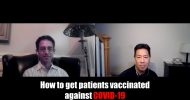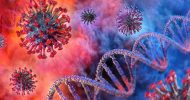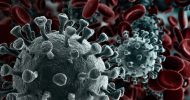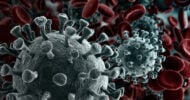March 15, 2020. The luke-warm water burns my hands for a few seconds; maybe this is how a snowman feels as it disintegrates on the first day of spring. Soon, my fingers loosen, but the sensation is fleeting. I dry my hands, put on another pair of gloves, then clean the stethoscope I’ve been using for the last several patients. I’ve been told that these are single-use, that I should use a new stethoscope for every patient. But we’re going to see 90 patients at this COVID-19 assessment clinic today, three times what we saw yesterday. We have a limited supply of testing swabs – there’s no way we have enough disposable stethoscopes for everyone.
The cleansing towelettes are alcohol-based, and my hands become frigid and stiff as I clean the scope’s tubing. I lay the scope onto a clean surface, then change my gloves again. Like everything, glove supply is finite too.
“It’s freezing, out here,” I tell Angela, the nurse who’s paired with me. “I think the idea to set up an assessment center outside the hospital came before we figured out that this virus isn’t airborne.”
None of this was thought out well. The desk I’ve been given is above a sewer grate. Every few seconds, I get a waft of waste. And this isn’t just ordinary waste. This is hospital waste. COVID-19 isn’t the only reason I’m wearing a mask.
And although this place is cold and stinky, it’s amazing that this clinic actually exists. On Thursday, in the absence of guidance from public health or the government, our ER’s leadership threw around ideas. The next day, this clinic was set-up, staffed, and running.
“Ready for the next patient?” Angela says.
“Hold on,” the security guard says. “Can’t bring in anyone until the ambulance offloads its patient.”
The massive entry and exit doors to the garage are closed. Dividers are set up to make two lanes in our EMS bay – one for ambulances and one for cars carrying patients into our makeshift drive-through COVID-19 clinic.
Angela shows me the next patient’s chart and points to his address.“Maybe they couldn’t test him there, so he’s driven two hours for testing here.”
A door opens, and the ambulance pulls out. Cold air blows in. The guard gets the make, model, and plate number of the next patient to be seen. He heads to the parking lot, chats with the driver, then waves him toward the ambulance bay. The entry door opens, and my next patient pulls up in a pick-up.
I’m wearing a mask, a face shield, and tight blue gloves. My arms are crossed over my chest for warmth. I’m told I can use one of the cheap yellow gowns, but I’m using one of the thick impermeable ones because it’s so cold. And I’m wearing it over my winter jacket. I give the masked driver a thumbs-up and motion him to roll down his window. Dave Sterling* is forty-four years old and generally healthy. “I was in Chicago from Monday to Thursday,” he says. “On Friday morning, I got a call saying that I’d had contact with someone who’s COVID-positive.”
“How do you feel?”
“I was fine,” he says, “until Friday afternoon – two days ago. I started coughing and feeling generally crappy. I don’t know if I’ve had a fever because, well, I’m living in a hotel right now, and I don’t have access to a thermometer.”
“You’re living in a hotel?”
“Well, here’s my problem,” he says. “I have a nine-year-old son who’s on a medication called Tacrolimus for an autoimmune disorder,” I tell him that I’m familiar with Tacrolimus, but that I usually see it prescribed to adults. It’s often used in transplant patients to suppress their immune systems so that they don’t reject their transplanted organs. “So, basically, I’m not going to go home if there’s any chance that I have the virus.”
There are still no firm guidelines on who to swab, I tell him, and I explain that if the guidelines had been followed as sent out by Public Health, then I probably wouldn’t have a swab left even if I wanted to test him. “I understand,” he says. The guidelines, I explain, tell me to swab anyone with a fever, a cough, and a positive travel history, even though the ground on which we stand is in a country with local transmission. Thus, travel history is meaningless.
“I’ve seen twenty patients already today, and I’ve only swabbed one patient. We just don’t have enough swabs to …”
I barely finish my sentence when he says it again. “I totally understand.”
I’ve heard this over and over today. I understand. The patients I’ve seen range in age from four to seventy-nine. Some have coughs; some don’t. Some have fevers; some don’t. I’ve looked in ears and throats. I’ve listened to hearts and lungs. More than anything, I’ve counseled patients. I’ve told them that if they have a cough and fever, they should assume they have it and stay home. I’ve told those with underlying illnesses that they’re okay for now, but if they become short of breath, they should come back. Fortunately, today, the patients I’ve seen with fever and cough have very mild illness.
David barely has a cough, and he has no documented fever. Today, when the triage nurse took his temperature before asking him to go back to his car, he was thirty-six degrees Celsius.
I run through guidelines in my head, as I have so many times today. I can’t sit down and study an algorithm. And I can’t call a colleague and debate whether or not to swab David. Like the people who worked so hard to set up this clinic, I just don’t have the time. There are a dozen cars waiting outside and more patients registering in the waiting room.
“I’m going to swab you,” I say. “I don’t want you to go home unless you know that you don’t have it.” The virus is no risk to him, but his son is a member of the at-risk population.
He doesn’t say anything, but his eyes are instantly watery. When he does speak, I realize he’s crying. “Thank you,” he says. “Thank you.”
The next day, I call him. “I’ll check the results every day,” I tell him. “The minute the results come back, I’ll let you know.”
Raj Waghmare is an emergency physician who blogs at ERTales.com.
Image credit: Shutterstock.com





















![AI in American medicine [PODCAST]](https://www.kevinmd.com/wp-content/uploads/AI-in-American-medicine-190x100.jpg)



![A tribute to primary care [PODCAST]](https://www.kevinmd.com/wp-content/uploads/A-tribute-to-primary-care-190x100.jpg)
